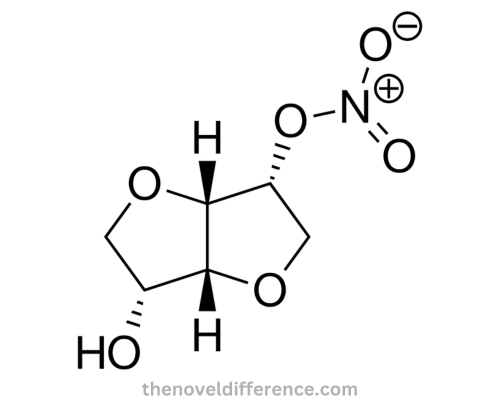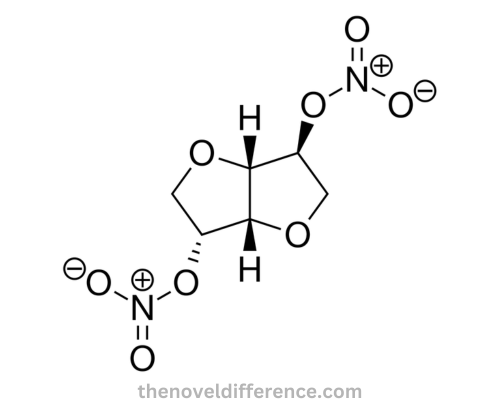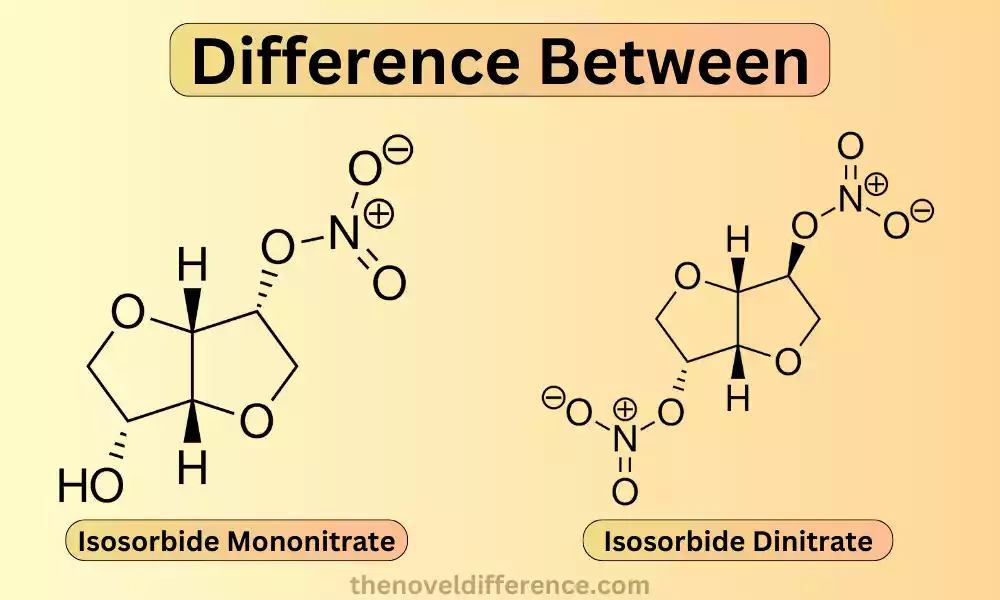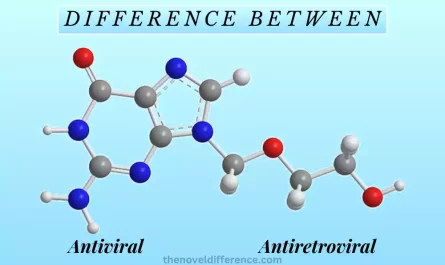Overview of Isosorbide Mononitrate and Isosorbide Dinitrate
Mononitrate and Dinitrate Isosorbide:
Isosorbide Mononitrate:
It belongs to the nitrate class of medications. It is used primarily to treat and prevent angina pectoris. This condition is characterized by chest discomfort or pain caused by a reduced blood supply to the heart muscle. Isosorbide mononitrate improves blood flow by dilation of the blood vessels. This reduces the workload placed on the heart.
Isosorbide mononitrate is explained in a few key points:
- Chemical Formula and Structure: The chemical formula of isosorbide mononitrate is C6H9NO6 with a molecular mass of 191.14g/mol. It is made from isosorbide (sugar alcohol).
- Pharmacological properties: The isosorbide mononitrate acts as a vasodilator, relaxing and widening the blood vessels. This includes the veins. This reduces resistance to blood flow and the pressure that the heart must pump against. It improves blood supply to the heart muscle.
- Mechanism: The body converts isosorbide mononitrate into 5-mononitrate. This metabolite releases nitric oxygen (NO), which is a powerful vasodilator. Guanylate-cyclase is activated. Guanylate cyclase catalyses the production of cyclic monophosphate (cGMP), an endogenous neurotransmitter responsible for relaxing smooth muscle cells on blood vessel walls to increase vasodilation and cause vasodilation.
- Medical Uses: The main use of isosorbide mononitrate in medicine is to treat and prevent angina pectoris. This includes chronic stable angina, and variant angina (Prinzmetal’s angina). It is not meant to relieve angina immediately, but rather as a long-term treatment that reduces the frequency and severity.
- Dosage forms: The isosorbide mononitrate comes in a variety of oral dosage forms including tablets and capsules with extended-release. Extended-release formulations are available in a once-daily dose and provide sustained release over a long period of time.
- Dosage and Administration: The dose of isosorbide mononitrate can vary depending on an individual’s condition, and their response to treatment. The medication is taken either with or without food. As the medication is designed to release slowly, it should not be crushed, chewed or divided.
- Contraindications and Precautions: Use isosorbide mononitrate with caution if you have low blood pressure or hypovolemia. Contraindications include severe anemia, closed angle glaucoma and known hypersensitivity towards nitrates.
- Side effects: Common isosorbide mononitrate side effects may include headaches, nausea, flushing and hypotension. These side effects are usually mild and temporary. Rarely, but they can happen, serious side effects like severe hypotension (fainting), syncope or allergic reactions.
This is only a general overview. Specific dosage instructions, side effects, and precautions may differ. Consult a medical professional or the package insert of your medication for accurate, up-to date information.
Isosorbide Dinitrate:
Antares belongs to a class of drugs called nitrates. Its primary use is treating and preventing angina pectoris – angina is defined by chest discomfort due to insufficient blood flow to the heart muscle causing decreased oxygen.
Isosorbide Dinitrate dilates the blood vessels and improves blood flow. It also reduces the workload of the heart.
This article will provide you with an overview of the isosorbide dinitrate:
- Chemical Formula and Structure: The chemical formula of isosorbide dinitrate is C6H8N2O8 with a molecular mass of 236.14g/mol. It is made from sugar alcohol isosorbide.
- Pharmacological properties: The isosorbide dinitrate relaxes blood vessels and increases their size, especially veins. This reduces resistance to blood flow, and the pressure that the heart must pump against. It improves blood supply to the heart muscle.
- Mechanism: Nitric oxide (NO) is produced by the body when it converts its inactive form, isosorbide dinitrate. Nitric oxide acts to activate guanylate-cyclase, catalyzing its production of cyclic monophosphate (cGMP). This compound relaxes smooth muscle cells within the walls of blood vessels, causing vasodilation.
- Medical Uses: The main use of isosorbide dinitrate in medicine is to treat and prevent angina pectoris. This includes chronic stable angina, and variant angina (Prinzmetal’s angina). It is not meant to relieve angina immediately, but instead for long-term treatment in order to reduce the frequency of attacks.
- Dosage forms: The isosorbide dinitrate comes in a variety of oral dosage forms including extended-release capsules and tablets. It can be taken sublingually in the form of a tablet, spray or spray to relieve angina symptoms.
- Dosage and Administration: The dose of isosorbide dinitrate can vary depending on an individual’s condition, and their response to treatment. It is usually taken orally with or without any food. Sublingual sprays or tablets can be used to relieve angina symptoms immediately, as directed by your healthcare provider.
- Contraindications and Precautions: Use Isosorbide dinitrate with caution if you suffer from low blood pressure or hypovolemia. Contraindications include severe anemia, closed angle glaucoma and known hypersensitivity towards nitrates.
- Common Side Effects: Side effects of isosorbide Dinitrate include headache, dizziness and nausea. These side effects are usually mild and temporary. Rarely, but they can happen, with serious side effects like severe hypotension (fainting), syncope or allergic reactions.
This is only a general overview. Specific dosage instructions, side effects, and precautions may differ. Consult a medical professional or the package insert of your medication for accurate, up-to-date information.
Definition and Composition
Both isosorbide mononitrate (also known as isosorbide dinitrate) and isosorbide dinitrate are medications that fall into the nitrate class. These organic compounds are derived from sugar alcohol isosorbide.
Here is a short description and composition for each:
- Isosorbide Mononitrate:
-
- Definition: The long-acting medication isosorbide mononitrate, a nitrate used to treat and prevent angina pectoris. It is a vasodilator that relaxes and opens the blood vessels to improve blood flow.
- Composition: Isosorbide mononitrate is chemically known as 1,4:3,6-dianhydro-D-glucitol 5-mononitrate. Its chemical name is C6H9NO6, with a molecular mass of 191.14g/mol.
- Isosorbide Dinitrate:
-
- Definition: The isosorbide dinitrate used to treat and prevent angina pectoris. It is a vasodilator that dilates the blood vessels, improving blood flow.
- Composition: Isosorbide dinitrate is chemically known as 1,4:3,6-dianhydro-D-glucitol 2,5-dinitrate. Its chemical name is C6H8N2O8 and its molecular mass is 236.14g/mol.
The body converts both isosorbide mononitrate and dinitrate to nitric dioxide (NO), activating the enzyme guanylate-cyclase, which leads to cyclic guanosine Monophosphate (cGMP).
This leads to the relaxation of the smooth muscle cells within the blood vessels and improved blood flow.
While both medications share the same chemical structure and core compound, they differ in terms of their specific nitrate compositions and groups. This results in differences in their clinical effects and pharmacokinetics.
What is Isosorbide Mononitrate (Isosorbide Mononitrate)?
It is used to treat and prevent angina pectoris. This condition causes chest pains or discomfort due to reduced blood flow. It is a nitrate and acts as vasodilator.
Isosorbide Mononitrate relaxes and widens the blood vessels in particular the veins. This vasodilation decreases resistance to blood flow, and the pressure that the heart must pump against. It improves blood supply to heart muscle. Isosorbide mononitrate improves blood flow and relieves symptoms of angina such as tightness or chest pain.

Some key facts about isosorbide Mononitrate:
- Indications: The main indications for isosorbide mononitrate are the treatment and prevention of angina pectoris. This includes chronic stable angina, and variant angina (Prinzmetal’s angina). It is not meant to relieve angina immediately, but instead for long-term treatment in order to reduce the frequency of attacks and severity.
- Dosage forms: The isosorbide mononitrate comes in a variety of oral dosage forms including tablets and capsules with extended-release. Extended-release formulations are available in a once-daily dose and provide sustained release over a long period of time.
- Dosage and Administration: The dose of isosorbide mononitrate can vary depending on an individual’s condition, and their response to treatment. It is usually taken orally with or without food. As the medication is designed to release slowly, it should not be crushed, chewed or divided.
- Contraindications and Precautions: Use isosorbide mononitrate with caution if you have low blood pressure or hypovolemia. Contraindications include severe anemia, closed-angle glaucoma, and known hypersensitivity towards nitrates.
- Side effects: Common isosorbide mononitrate side effects may include headaches, dizziness, and nausea. These side effects are usually mild and temporary. Rarely, but they can happen, with serious side effects like severe hypotension (fainting), syncope, or allergic reactions.
Important: Isosorbide mononitrate must be taken under the supervision of a medical professional. Specific dosage instructions and precautions can vary depending on the individual’s condition. Consult a doctor or the package insert of your medication for accurate, up-to-date information.
What is Isosorbide Dinitrate (Isosorbide Dinitrate)?
It is used to treat and prevent angina pectoris. This condition causes chest pains or discomfort due to reduced blood flow. It is a nitrate and acts as a vasodilator.
It works by relaxing the blood vessels and increasing blood flow. This vasodilation decreases resistance to blood flow, and the pressure that the heart must pump against. It improves blood supply to heart muscle. Isosorbide dinitrate improves blood flow and relieves symptoms of angina such as tightness or chest pain.

Some key facts about isosorbide Dinitrate:
- Indications: The isosorbide dinitrate used to treat and prevent angina pectoris including chronic stable and variant angina (Prinzmetal’s angina). It is not meant to relieve angina immediately, but instead for long-term treatment in order to reduce the frequency of attacks and severity.
- Dosage forms: The isosorbide dinitrate comes in a variety of oral dosage forms including tablets and capsules with extended-release. It can be taken sublingually in the form of a tablet or spray to relieve angina symptoms.
- Dosage and Administration: The dose of isosorbide dinitrate can vary depending on an individual’s condition, and their response to treatment. It is usually taken orally with or without any food. Sublingual sprays or tablets can be used to relieve angina symptoms immediately, as directed by your healthcare provider.
- Contraindications and Precautions: Use isosorbide dinitrate with caution in patients who have low blood pressure or hypovolemia. Contraindications include severe anemia, closed angle glaucoma and known hypersensitivity towards nitrates.
- Side effects: Common isosorbide side effects may include headaches, dizziness and nausea. These side effects are usually mild and temporary. Rarely, but they can happen, with serious side effects like severe hypotension (fainting), syncope or allergic reactions.
Isosorbide Dinitrate is best used with the help of a medical professional. Specific dosage instructions and cautions can vary depending on a person’s condition. Consult a medical professional for the most accurate and current information.
What is the difference between Mononitrate and Dinitrate Isosorbide?
Both isosorbide mononitrate (also known as isosorbide dinitrate) and isosorbide dinitrate (also known as isosorbide) are used to treat angina pectoris. However, they differ in their clinical application and properties. Here are the key differences between isosorbide mononitrate (mononitrate) and isosorbide dinitrate (dinitrate).
- Chemical structure: The chemical structure of isosorbide mononitrate versus isosorbide dinitrate differs. Isosorbide mononitrate, on the other hand, is a mononitrate ester. Pharmacokinetics – which measures how they are processed by the body – is greatly influenced by chemical structure differences between drugs.
- Duration and Onset of Action: The isosorbide mononitrate has a prolonged duration of action. It is an extended-release drug that releases the medication over time. Isosorbide Dinitrate is a nitrate that acts quickly and relieves angina symptoms more immediately. It is used to relieve acute symptoms or in situations that require rapid vasodilation.
- Available dosage forms: The isosorbide mononitrate comes in a variety of oral dosage forms such as extended-release capsules and tablets. It is usually taken once daily. Sprays, sublingual tablets and oral tablets are all available for isosorbide dinitrate. Sublingual tablets are intended for rapid absorption beneath the tongue to relieve angina symptoms.
- Dosage frequency: Isosorbide mononitrate, due to its long-acting properties, is usually taken once per day, whereas isosorbide dinitrate can be taken as many times as necessary for immediate symptomatic relief.
- Clinical Use: The isosorbide mononitrate used to treat chronic stable angina can be prescribed for long-term treatment and prevention. The extended-release formula has a sustained and steady effect that reduces the severity and frequency of angina attacks. Its faster onset of effect is used to treat angina symptoms and in situations that require rapid vasodilation.
The choice between isosorbide mononitrate or isosorbide dinitrate is based on a number of factors. These include the patient’s health, the severity and duration of the angina symptoms, and the timing and duration of the nitrate effect.
To determine the ideal medication and dosage regimen for any individual patient, it is critical to seek advice and follow the recommendations of healthcare professionals.
Isosorbide Mononitrate vs Isosorbide Dinitrate in Tabular Form
Certainly! Here’s a tabular comparison of key aspects between isosorbide mononitrate and isosorbide dinitrate:
| Aspect | Isosorbide Mononitrate | Isosorbide Dinitrate |
|---|---|---|
| Chemical Structure | Mononitrate ester | Dinitrate ester |
| Onset of Action | Slow | Rapid |
| Duration of Action | Long | Short |
| Dosage Forms | Tablets, extended-release capsules | Tablets, sublingual tablets, sprays |
| Dosage Frequency | Once daily | Multiple times a day (as needed) |
| Clinical Use | Prevention and long-term management of | Acute relief of angina symptoms, variant |
| chronic stable angina | angina, rapid vasodilation | |
| Metabolism | Extensive first-pass metabolism in the liver | Extensive first-pass metabolism in the liver |
| Elimination Half-Life | 4-5 hours | 1-4 hours |
Please note that this table provides a concise overview of the main differences between the two medications and is not an exhaustive comparison.
Individual variations and specific patient considerations may influence the choice between isosorbide mononitrate and isosorbide dinitrate. Always consult a healthcare practitioner for tailored medical advice and treatment options.
Medical Uses
Both isosorbide mononitrate (also known as isosorbide dinitrate) and isosorbide dinitrate are used to treat and prevent angina pectoris. This condition is characterized by chest discomfort or pain caused by a reduced blood supply to the heart muscle. There are differences between their medical uses.
Isosorbide Mononitrate:
- Chronic stable Angina: The isosorbide mononitrate is prescribed to treat and prevent chronic stable angina on a long-term basis. It reduces the severity and frequency of angina attacks by improving blood flow and dilating blood vessels.
Isosorbide Dinitrate:
- Acute Attacks of Angina: The immediate relief from angina symptoms is usually achieved by using isosorbide dinitrate during acute attacks. Its rapid vasodilator effects relax blood vessels quickly, increasing blood flow to relieve chest pain.
- Variant Angina (Prinzmetal’s): The treatment for variant angina is to prescribe isosorbide dinitrate. This type of angina is a result of coronary artery spasm. Isosorbide dinitrate can help relieve the spasms by relaxing blood vessels.
Isosorbide mononitrate can be used to treat and prevent chronic stable angina. It is also prescribed as a treatment for angina attacks.
Healthcare providers will determine which medication will best meet each individual patient’s unique requirements and medical condition.
Pharmacokinetics
Due to the differences in their chemical structure and formulation, isosorbide mononitrate pharmacokinetics differs from isosorbide dinitrate.
Here is an overview of the pharmacokinetics:
Isosorbide Mononitrate:
Absorptive Capacity: The isosorbide mononitrate when administered orally is rapidly and completely absorbed by the body. Extended-release formulations allow for a sustained release over time of the medication, which results in a gradual absorption profile.
Distribution: The isosorbide mononitrate has a wide distribution throughout the body. This includes the smooth muscles of the vessels. It is widely distributed in tissues, as indicated by its high volume.
Metabolism: Isosorbide mononitrate undergoes intensive first-pass metabolism in the liver, where it is converted to its active form isosorbide-5-mononitrate (ISMN). ISMN is the cause of isosorbide mononitrate’s vasodilatory effect. Denitration and conjugation reactions are involved in the metabolism of isosorbide mononitrate.
Elimination of Isosorbide: Mononitrate has a half-life of between 4 and 5 hours. It is primarily removed from the body by hepatic metabolic processes and renal excretion.
Isosorbide Dinitrate:
Absorption: The isosorbide dinitrate is absorbed rapidly after oral administration. Sublingual administration allows rapid absorption into the bloodstream.
Distribution: The isosorbide dinitrate is distributed in the entire body, including the smooth muscles of the vessels. It is distributed in a moderate amount.
Metabolism: Isosorbide dinitrate undergoes rapid first-pass metabolism in the liver, producing isosorbide-2-mononitrate and isosorbide-5-mononitrate which are its principal active metabolites that contribute to its vasodilatory properties. These two metabolites account for most of its effects.
Elimination Isosorbide: Dinitrate has a half-life ranging from 1 to 4 hrs. It is primarily removed from the body by hepatic metabolic processes and renal excretion.
You should be aware that individual variations can occur in pharmacokinetics based on factors like age, liver function and interactions with other drugs. For any inquiries concerning pharmacokinetics or drug interactions, it is always a good idea to speak to a healthcare provider.
Side Effects and Adverse Reactions
Side effects and adverse reactions can occur with both isosorbide mononitrate and dinitrate. These medications may cause side effects.
Headache is the most common side effect reported for both isosorbide mononitrate and dinitrate. Usually mild and transient but can sometimes be severe.
Lightheadedness: You may feel dizzy or lightheaded, particularly when you stand up suddenly or change positions. To minimize the chance of accidents or falls, it is important to move at a slow pace.
Flush: A flushing sensation, which is characterized by redness and warmth in the skin, can be caused by the dilation of blood vessels. It is typically temporary and benign.
Hypertension: Both drugs can cause a fall in blood pressure that leads to hypotension. Lightheadedness, fainting, and dizziness are all possible symptoms. Monitoring blood pressure is essential, especially when you start a medication or adjust the dosage.
Nausea Some people may experience nausea after taking isosorbide mononitrate or dinitrate. This side effect can be reduced by taking the medication with a meal.
Allergic reactions: Although rare, allergic reactions to isosorbide mononitrate or dinitrate may occur. An allergic reaction could present itself with symptoms like redness, swelling, itching, or severe dizziness. If you suspect an allergic reaction is taking place, get medical help immediately and consult the following list:cts
Note that this list may include additional side effects: Consult a medical professional or check the package insert of your medication for a complete list of side effects and adverse reactions.
Individuals may also react differently to the medications. Side effects will differ according to who is experiencing them and the circumstances they find themselves in.
Precautions and Contraindications
When taking isosorbide mononitrate or dinitrate medications, it is essential to be aware of their contraindications and precautions. Each medication comes with specific potential issues or precautions that should be considered when using it.
Precautions:
Hypotension: Patients experiencing low blood pressure, hypovolemia, or on an isosorbide mononitrate/dinitrate medication could experience a drop in their blood pressure levels. Blood pressure should be monitored regularly, especially when initiating therapy or adjusting the dosage.
Hypovolemia: Hypovolemia may result in further decreases in blood pressure.
Cardiovascular Conditions: Due to increased hypotensive effects, individuals suffering from cardiovascular conditions such as severe cardiomyopathy or hypertrophic obstructive heart disease must exercise extreme caution when taking isosorbide mononitrate or dinitrate medications containing either one of them – particularly combination medications like isosorbide mononitrate/dinitrate combination drugs.
Patients Recovering: From Myocardial Infarction Should Approach Isosorbide Mononitrate and Dimitrate Cautiously – Patients recovering from a recent heart attack should use isosorbide mononitrate or dinitrate with extreme care as their hypotensive effect could be more powerful than expected.
Anemia: Patients suffering from severe anemia should use Isosorbide mononitrate and dinitrate with caution as this could worsen symptoms associated with reduced oxygen-carrying capacity.
Contraindications:
Hypersensitivity: People who have previously shown any hypersensitivity to isosorbide mononitrate and dinitrate or any other nitrates should avoid taking these medicines.
Closed-Angle Glaucoma: Closed-angle (or ocular) glaucoma patients must not use Isosorbide mononitrate and dinitrate because this condition leads to increased pressure inside of their eyeballs.
Concurrent Use of Phosphodiesterase-5 (PDE-5) Inhibitors: Contraindicated combinations include taking sildenafil or tadalafil with PDE-5 inhibitors such as mononitrate isosorbide; their combination may result in severe blood pressure drops.
Use of Riociguat: Due to the risk of severe hypotension, isosorbide mononitrate or dinitrate should not be administered when taking riociguat as part of treating pulmonary arterial hypertension. This medication requires dosage adjustments depending on the patient’s physiology.
The contraindications and precautions listed aren’t exhaustive – for more in-depth knowledge of this medicine’s adverse reactions or precautions please speak with a qualified health provider or read its package insert. Individual patient factors and medical history should be considered before initiating treatment.
Conclusion
Both isosorbide mononitrate and dinitrate are widely prescribed medications used for the treatment of angina pectoris; however, each comes with important differences.
Isosorbide mononitrate is primarily prescribed to prevent and manage long-term stable angina using its long-acting release over time with a once-daily dosage, while isosorbide dinitrate acts quickly to provide rapid vasodilation during acute attacks or situations needing immediate vasodilation with its rapid onset action that allows rapid vasodilation when needed-making its administration ideal.
These medications possess distinct pharmacokinetic profiles: Isosorbide mononitrate is well absorbed, undergoes extensive first-pass metabolism, and has a prolonged half-life; while isosorbide dinitrate has rapid absorption; however it undergoes less first-pass metabolism with shorter elimination half-lives. Both medications may lead to adverse side effects that include headaches, dizziness, flushing, hypotension, and nausea.




